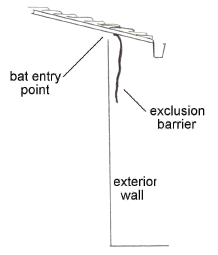When bats and humans come into close contact, the potential for humans to contract bat-borne diseases increases. Bats are capable of transmitting two known diseases to humans: rabies and histoplasmosis. The chances of contracting either of these diseases is extremely low. A study that examined a 40 year period in the United States and Canada uncovered 16 deaths resulting from bat-borne diseases. Between 1995 and 2013, there have been 51 documented deaths from rabies in the United States. Today, there are effective rabies vaccines that can be given to humans. Also, as most dogs are vaccinated for rabies, they are no longer considered to be common carriers of the disease – wildlife species now account for approximately 92% of reported rabies cases.
Rabies is a viral infection that is always fatal when left untreated. Recently, there have been a few people who have recovered from rabies because of improved early extensive care. Because bats can carry the rabies virus, they should never be handled. Their only defense mechanism is their bite, which is the primary route for rabies transmission from an infected bat to a human or other animal. Bats that are found on the ground, active during the day, discovered in a swimming pool, caught by a dog or cat or are unable to fly are more likely to be infected with rabies. Avoid contact with any wild animals, especially if they seem ill. Call your local animal control services for help.
Histoplasmosis is a fungal infection causing a flu-like respiratory disease. It is contracted by breathing dust stirred up in areas where bat or bird droppings have accumulated. The symptoms of histoplasmosis can become severe, and if left untreated can lead to death. Histoplasmosis is extremely rare to non-existent in California. The disease is seen in humans in midwestern and eastern states, but is still quite rare.
Like many mammals, bats are plagued by parasites such as fleas, ticks, mites, bugs and flies. Most of these parasites don’t leave the bats for other hosts. Often they are host-specific, even preferring a single bat species. However, if a colony of bats is destroyed in a home or workplace, some of these parasites will search for a new host to feed on, and this may include you. The key in preventing bat-borne diseases is to avoid human – bat contact. Close associations where bats roost in areas occupied by humans pose unacceptable public health risks.
Bats have a poor reproductive potential, producing 1 and rarely 2 offspring per year. This makes it difficult for a population of bats to repopulate after suffering a loss of numerous individuals due to rabies, habitat destruction or disturbance. When mitigating close human-bat associations, it is NOT recommended that bats be destroyed. The preferred method is exclusion, as bats can be evicted from buildings occupied by humans without bringing any harm to them. Many bat species in the United States are listed by the Environmental Protection Agency as either threatened or endangered. Bats are very effective plant pollinators, and help to pollinate many food crops important for both human and animal consumption. Bats are also excellent biological control agents, as they eat millions of mosquitoes and other potentially harmful insects.
At dusk, bats can be seen exiting through their normal access points on their way to begin feeding. Later, during daytime hours, these exit points can be better identified. Bats often enter a building through small cracks under eaves, inside chimneys, under a roof shingle or through a hole made by a bird or rodent. Some openings can be confirmed by the presence of body oils staining the edges of openings or by bat droppings near or below openings. Bat droppings can be distinguished from rodent droppings as the older dry droppings of bats easily crush into fine fragments between your fingers. Once the openings have been located, they can be covered with flashing, 1/4” hardware cloth or plastic netting to exclude the bats. It is important not to trap bats inside a building where they could die. By constructing a simple, one-way door at one or two of the exit points, bats will be able to escape, but will not be able to re-enter. The best time to exclude bats is during the late fall or winter months, when adults still feed at night, and when young bats, unable to fly, are not present.

Constructing a one-way door is not as difficult as it may seem. Attach a small plastic tarp or something smooth as a barrier just above the opening with duct tape, staples or by other appropriate means. The use of towels or netting won’t work as they can provide a way for the bats to climb back up to re-enter the opening. The barrier should not hang more than 4 inches out from the opening and should extend a foot or two to either side and below the opening. This will allow an easy exit for the bats, but prevent them from re-entering. Do not attach the barrier at the bottom or along the sides. After discovering they cannot enter, the bats will leave and search for another roosting site. Allow at least one week to pass before assuming that all of the bats have vacated the building before taking more permanent measures to bat proof the building. Repellents such as noise makers, mothballs and metallic streamers are rarely effective. Aerosol repellents are not an adequate substitute for exclusion, and should never be applied or sprayed into an area while bats are roosting. Some pest control companies may help or be able to refer you to companies or persons who do bat removal and bat exclusion professionally.
If you find a dead or sick bat, do not touch or handle it. The bat will probably try to bite you. Any sick or dead bat should be treated as if it were infected with rabies. Call local animal control so they can collect the bat and assess any possible exposures to bat bites. They will take the necessary steps to insure that your health and the health of others involved is protected. If you need help with a bat problem, contact our office. We can provide you with a specific recommendation to help you take action toward eliminating the problem. In Sutter County, animal control services will pick up bats and the Sutter County Environmental Health Lab will test them. In Yuba County, animal control services will also collect bats and have them tested, usually at the Placer County Environmental Health Lab. Both are state approved laboratories.
